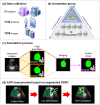PSFHS: Intrapartum ultrasound image dataset for AI-based segmentation of pubic symphysis and fetal head
- PMID: 38698003
- PMCID: PMC11066050
- DOI: 10.1038/s41597-024-03266-4
PSFHS: Intrapartum ultrasound image dataset for AI-based segmentation of pubic symphysis and fetal head
Abstract
During the process of labor, the intrapartum transperineal ultrasound examination serves as a valuable tool, allowing direct observation of the relative positional relationship between the pubic symphysis and fetal head (PSFH). Accurate assessment of fetal head descent and the prediction of the most suitable mode of delivery heavily rely on this relationship. However, achieving an objective and quantitative interpretation of the ultrasound images necessitates precise PSFH segmentation (PSFHS), a task that is both time-consuming and demanding. Integrating the potential of artificial intelligence (AI) in the field of medical ultrasound image segmentation, the development and evaluation of AI-based models rely significantly on access to comprehensive and meticulously annotated datasets. Unfortunately, publicly accessible datasets tailored for PSFHS are notably scarce. Bridging this critical gap, we introduce a PSFHS dataset comprising 1358 images, meticulously annotated at the pixel level. The annotation process adhered to standardized protocols and involved collaboration among medical experts. Remarkably, this dataset stands as the most expansive and comprehensive resource for PSFHS to date.
© 2024. The Author(s).
Conflict of interest statement
The authors declare no competing interests.
Figures

Similar articles
-
PSFHSP-Net: an efficient lightweight network for identifying pubic symphysis-fetal head standard plane from intrapartum ultrasound images.Med Biol Eng Comput. 2024 Oct;62(10):2975-2986. doi: 10.1007/s11517-024-03111-1. Epub 2024 May 9. Med Biol Eng Comput. 2024. PMID: 38722478 Free PMC article.
-
PSFHS challenge report: Pubic symphysis and fetal head segmentation from intrapartum ultrasound images.Med Image Anal. 2025 Jan;99:103353. doi: 10.1016/j.media.2024.103353. Epub 2024 Sep 21. Med Image Anal. 2025. PMID: 39340971
-
RTSeg-net: A lightweight network for real-time segmentation of fetal head and pubic symphysis from intrapartum ultrasound images.Comput Biol Med. 2024 Jun;175:108501. doi: 10.1016/j.compbiomed.2024.108501. Epub 2024 Apr 22. Comput Biol Med. 2024. PMID: 38703545
-
Descent of the presenting part assessed with ultrasound.Am J Obstet Gynecol. 2024 Mar;230(3S):S901-S912. doi: 10.1016/j.ajog.2021.08.030. Epub 2021 Aug 27. Am J Obstet Gynecol. 2024. PMID: 34461079 Review.
-
Intrapartum ultrasound and the choice between assisted vaginal and cesarean delivery.Am J Obstet Gynecol MFM. 2021 Nov;3(6S):100439. doi: 10.1016/j.ajogmf.2021.100439. Epub 2021 Jun 30. Am J Obstet Gynecol MFM. 2021. PMID: 34216834 Review.
Cited by
-
Editorial: New technologies improve maternal and newborn safety.Front Med Technol. 2024 May 30;6:1372358. doi: 10.3389/fmedt.2024.1372358. eCollection 2024. Front Med Technol. 2024. PMID: 38872737 Free PMC article. No abstract available.
-
Advancing prenatal healthcare by explainable AI enhanced fetal ultrasound image segmentation using U-Net++ with attention mechanisms.Sci Rep. 2025 Jun 4;15(1):19612. doi: 10.1038/s41598-025-04631-y. Sci Rep. 2025. PMID: 40467763 Free PMC article.
-
A multimodal model in the prediction of the delivery mode using data from a digital twin-empowered labor monitoring system.Digit Health. 2024 Dec 8;10:20552076241304934. doi: 10.1177/20552076241304934. eCollection 2024 Jan-Dec. Digit Health. 2024. PMID: 39669390 Free PMC article.
-
PSFHSP-Net: an efficient lightweight network for identifying pubic symphysis-fetal head standard plane from intrapartum ultrasound images.Med Biol Eng Comput. 2024 Oct;62(10):2975-2986. doi: 10.1007/s11517-024-03111-1. Epub 2024 May 9. Med Biol Eng Comput. 2024. PMID: 38722478 Free PMC article.
-
An annotated heterogeneous ultrasound database.Sci Data. 2025 Jan 25;12(1):148. doi: 10.1038/s41597-025-04464-4. Sci Data. 2025. PMID: 39863639 Free PMC article.
References
Publication types
MeSH terms
Grants and funding
LinkOut - more resources
Full Text Sources
Miscellaneous

